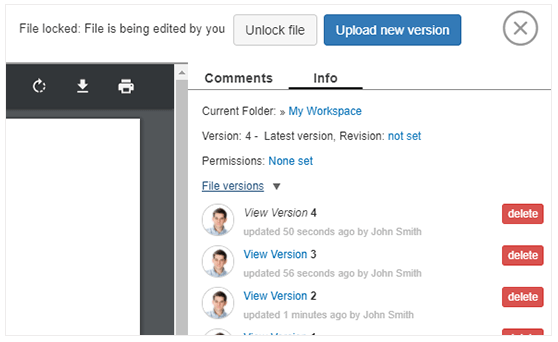Make Collaboration Painless With These 11 File Sharing Best Practices
on 28 December 2020
Before shared digital filing systems existed, companies were restricted to sharing files via email or hard copy. Paper systems require large amounts of physical space, which is why digital systems are so attractive. However, digital systems bring their own challenges.
We’ve all experienced limitations in email, particularly surrounding the attachment and/or downloading of large files. Even when we can attach them, there’s too much time involved in the uploading and downloading. Then, unless you use an intermediary encryption system, those files are quite insecure.
Alternatively, maybe you’ve used USB sticks or CDs. With many copies of documents flying around, it can be difficult to know if you are looking at or editing the latest version. Then you still don’t know who changed what, or when. This is bad enough when one person is responsible for a document; it’s even harder when many people are working on the same document.
The rise of consumer file sharing systems like Dropbox overcame some of these problems, but security is still a challenge. For example, if you store your files outside the EU, they may not be secure there either. Using a file sharing system specifically designed for organisational use, like Glasscubes, addresses these problems. However, you can’t just transfer your existing file structure over to a shared system if you want to gain all the advantages of the best online file sharing systems. To avoid some basic pitfalls, online file sharing requires a different approach.
Whether you’ve been using online file sharing for years or you’re just getting into the groove, here are eleven best practices to make file sharing online a breeze.
11 File Sharing Best Practices
1. Plan your shared file structure.
Most organisations are inconsistent in the way folders are named and structured. Often they’re mislabelled and forgotten when creating new folder structures. While this may not be a problem when everyone manages their own files locally, it can become a major problem when those structures are shared.
Good Practice:
- Keep documents with common compliance or retention rules together so they are easier to archive or delete as a group.
- Name folders according to function, not ‘Bob’s folder.’
- Keep it simple so people will remember it.
- Don’t go beyond three to five folder levels.
- Create and make accessible a file-structure policy.
- Be consistent with file structures and don’t allow exceptions.
You should also go one step further to avoid potential mix-ups with third parties: Separate external files from those meant for internal use. Allisa Lindo, growth marketing manager at Brandox, says, “In my experience, blending external and internal documents in the same folders is surprisingly common, and it's a recipe for disaster. Imagine a client getting internal planning documents. For companies operating in the EU, this could also be a potential GDPR issue.”
2. Develop consistent naming conventions.
Organisations not only have problems with the consistency of managing folders, but with the consistency of naming documents. Left to their own devices, people will name documents the way they want, which creates a major headache when searching for documents later.
Good Practice:
- Use names that are meaningful to everyone, but are not too long.
- Don’t include information that is already included in the digital copy, for example sometimes documents are automatically saved with dates and versions.
- Use terms that are easily recognised within your organisation.
- Be consistent in naming and don’t allow exceptions.
Amy Kilvington, content marketer at Blinds Direct, explains that if file naming is consistent, colleagues and clients will quickly understand the structure and implement it themselves, ensuring everyone is always on the same page.
She now also makes sure that file names conform to a specific file naming structure, thanks to an incident that highlighted the challenges of not doing so. “We previously hired a photography intern who photographed new products in batches. One batch of products arrived from a supplier who referred to them as ‘venetian blinds,’ and the intern named the files using that reference. However, our team typically referred to this style as either ‘wooden blinds’ or ‘aluminum blinds,’ depending on the material. This made tracking down the product photos tricky, especially as the intern left soon after! Since then, we ensure that all team members are briefed on the semantics of product names, as well as understanding our file naming conventions: supplier name, product name, and any other distinguishing factors, such as colour or pattern.”
3. Make it easy to find files.
Many online file sharing systems like Glasscubes have additional features to make it easier to find documents. Two examples would be a file search feature, a Google-like, enterprise search engine that searches title and content to find documents quickly; and labeling, tagging documents to make them searchable.
Good Practice:
- Make sure everyone is familiar with these additional features and how to use them.
- Agree on a system for using features like tags.
- Use only that system to avoid files getting lost.
4. Be collaborative with online file sharing.
Our working environment is changing rapidly, with a greater need to work with people in remote locations, both inside and outside organisational boundaries. Today’s online file sharing systems facilitate this reality.
Good Practice:
- Use collaboration options like document read, notification, approvals, and comments, which keeps everyone connected to the document for referral and auditing.
- ‘Follow’ documents so you always know when they are updated.
- Don’t allow multiple offline copies; all official documents should be in the shared folders.
- When you share files with external groups, use password protection (don’t send the document by email).
5. Limit access to files appropriately.
Not everyone will need the same access to all documents all of the time. Think about what you need to share and who needs to have access. Consider whether you might need to offer levels of permissions to firstly access content; also consider whether you have content that should be accessible for viewing or editing. Lastly, think about whether users might ever require access to files 'offline' using offline file synchronisation.
Good Practice:
- Keep permissions simple (then people will remember it).
- Keep a plan readily accessible.
- Be consistent with authorisation privileges and don’t allow exceptions.
There are many use cases for limiting access to certain files. Laurence Norah, photographer at Finding the Universe, says, “I often send clients proofs of photos that they can review before use. Obviously, I only want them to be able to see the photos relevant to themselves—and nothing else. So an appropriate folder structure, combined with using the sharing tools a good platform provides, is essential.”
Need detailed control over folder and file access? See it in action right now with a Glasscubes demo.
6. Use software to automatically manage document versions.
We’ve all had the experience of spending hours working on a document only to find that it wasn’t the latest version. Or, in melee of a busy project, finding we don’t actually know which copy of a document is the latest. It is frustrating and time-wasting. It makes approving documents more difficult. It also affects compliance as you have no clear audit trail.
Good online file sharing systems will, if used properly, manage versions for you.
Good Practice:
- Utilise the system to manage your document versions.
- Keep documents within the system to avoid losing versions.
7. Secure your data.
Your data is precious, so make sure it is safe and secure. Document security is often the main reason organisations move to using online file sharing.
Good Practice:
- Choose a file sharing solution that encrypts your data to keep it secure in transit.
- If you ever have to use email for document transmission, consider encrypting that data too.
- Don’t store local copies of documents.
Ignoring the importance of data security carries big risks—some that your company may not be able to recover from. “There's a good deal of liability involved if you don't take data security seriously,” says Nate Masterson, CEO of Maple Holistics. “For instance, your clients could find your lack of oversight unprofessional and take their business elsewhere. Alternatively, your competitors could take advantage of your exposed data. Either way, the result isn't favorable. Therefore, make sure you’re using a secure file sharing program and that all your employees use only that program. You don’t want random shares negating your data protection efforts.”
8. Determine how long you’ll retain documents.
Keeping documents longer than needed is a common problem with online systems. Documents are retained for a longer period of time, mostly because it is painful to purge the documents (paper or electronic) or simply because most people don’t know how long they are required to keep certain documents. Purging electronic files has become a larger problem than it was with paper, since hard drives have become more affordable.
Good Practice:
- Each industry has rules and regulations on how long your organisation must maintain a copy of your documents.
- Keep documents with common compliance or retention rules together so they are easier to archive or delete as a group.
- Don’t allow lots of offline copies of documents. All official documents should be in the shared folders.
“When it comes to file storage best practices, document retention is critical. You need to prune files regularly,” advises Emma Knightly, digital marketing specialist at Digital Marketing Institute. “With so many documents being stored and shared, it's important to keep file structures tidy by having a limit to how long files should be kept before being archived. It's also really important to be responsible for the files you keep and make sure to delete files which aren't necessary anymore.”
Knightly’s team goes so far as to set up a monthly calendar invite to remind everyone to go through the shared file drive, review documents, and archive and delete as appropriate. “This allows each person to take responsibility for any unnecessary files gathering in our file sharing program, ensuring that the drive stays organised and relevant,” she explains.
9. Regularly audit access to files.
Oftentimes you store and share files that are confidential or sensitive in nature. For example, an engineering firm might share with clients designs they wouldn’t want leaked to competitors. That’s why it’s important to regularly audit files to ensure only relevant parties have access.
Good practice:
- Check access to key files on a regular basis, such as monthly or quarterly.
- Periodically reevaluate the relevance of each user’s access.
“If you’re sharing and accessing confidential files, you need to establish a process for monitoring and reviewing access,” says Samantha Moss, editor & content ambassador at Romantific. “Be sure you have full auditability—where you’re able to see exactly who has access to a given file and when they accessed it. This is important for mitigating issues of file mismanagement and negligence.”
10. Periodically evaluate your file-sharing tool.
If you’ve been using your current file-sharing tool for a while, you may need to reevaluate whether it’s still meeting your team’s needs. Over time, workflows change and some tools don’t quite fit in anymore.
Good practice:
- Choose a reevaluation timeline that works for your organisation, such as on an annual basis.
- Check the market for tools that address your new or modified workflows; there may be new solutions available that didn’t exist when you chose your current one. (For example, your team may have gone remote recently, and you need more appropriate tools.)
“Dedicate time to evaluate your file-sharing solution,” says Moss. “Feedback is the key. Ask users for their honest thoughts on whether the solution helps or hinders their workflows. Then use those insights to determine whether searching for a new solution is warranted.”
11. Always keep file backups.
There’s nothing worse than losing an important file after spending dozens of man hours and holding multiple meetings to finalise the contents. This not only costs you time, but can also cost you a client in some situations.
Good practice:
- Maintain copies of files, especially critical ones, either offline or in the cloud.
- Choose a file-sharing solution that retains backups of your files for at least 30 days.
“You should have backup files of all the files being shared,” says April Maccario, founder of Ask April. “Even if you have a repository you feel is safe, take extra precautions to ensure you always have access to important documents. You’ll be grateful if the unthinkable happens and you can’t access that client presentation.”
Does your company need a document specialist? See how these business leaders are taking advantage of this unique role.
Set your team up for online file sharing success with Glasscubes.
Glasscubes makes online file storage and sharing easy, whether you use our solution exclusively for internal teams or want to loop in clients too. You can keep all files in a centralised location for easy discovery, and control who has access to a given file at any time. There are no restrictions on the types of files you can store and no limit on file sizes.
When you work in Glasscubes, you never have to be confused about whether the current version of a file is the most up to date—all files are automatically version-controlled when uploaded. Your team, the client team, and whoever else you give access to will always have the latest and greatest version. Plus, Glasscubes employs SSL encryption to ensure that data transfers between you and our servers are secure, and we encrypt all data at rest.

With Glasscubes, you can share files and so much more:
- Create approval workflows to ensure all relevant users have signed off on a document. You can request document approvals from a single user or a group.
- Control access to everything from whole workspaces to individual files. Ensure users see only what they are authorised to see.
- Collaborate around documents with threaded discussions for each file. Don’t get caught up in long, hard-to-follow email chains.
Plenty of users have chosen the one-and-done file sharing program that helps you store, share, and collaborate around files for ultimate team success. See how they’re using Glasscubes in these case studies.

